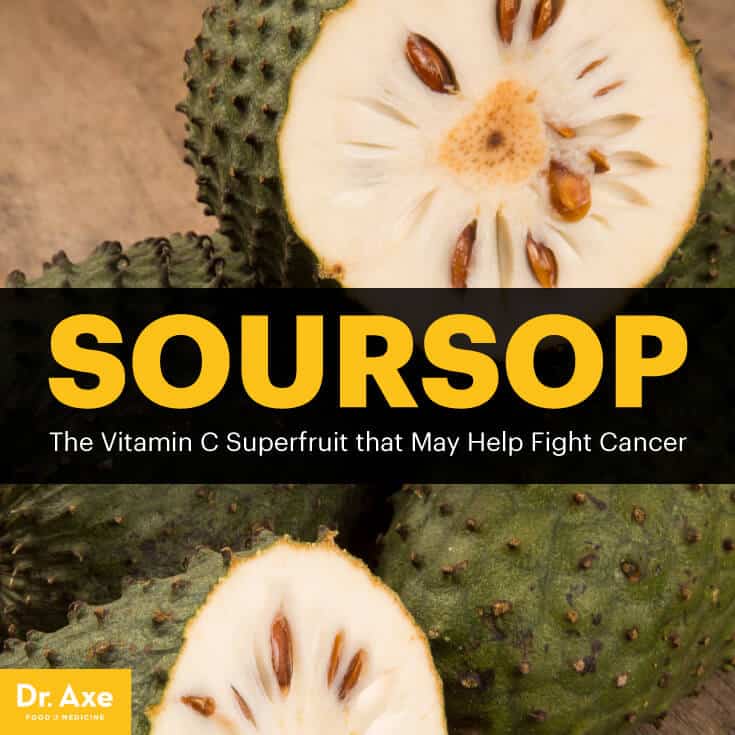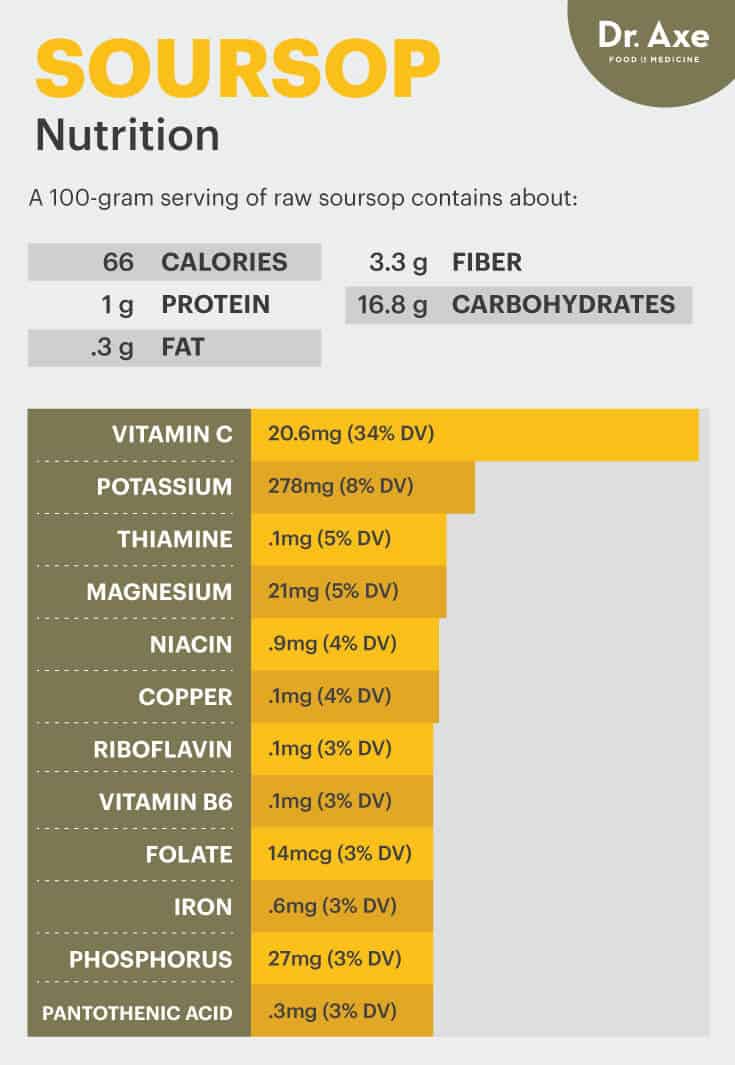
What if I told you there was a fruit that’s great for your eyes, can treat infections and even shows promise as a potential cancer-fighting food? Would you be interested? If you answered yes — and why wouldn’t you? — let me introduce you to soursop.
Soursop is usually found in South America and often the basis for beverages, ice creams and other popular sweet foods. It’s known to have a few other names, such as graviola, custard apple, paw paw, guyabano and guanabana in Spanish-speaking countries. Additionally, it has superfruit-healing properties as a high-antioxidant food due to its vitamin C, B vitamins, calcium, phosphorous and even some iron that it contains. These vitamins and minerals are why soursop benefits include potentially helping reduce eye disease, treat infections and potentially even fight cancer, among others.
Benefits of Soursop
1. Filled with Beneficial Antioxidants that May Help Reduce Eye Disease
Many of the health benefits from graviola, or soursop, are thought to be derived from its antioxidant properties. (1) Studies show that the phytonutrients that are found in the fruit are high in antioxidant compounds, including alkaloids, saponins, terpenoids, flavonoids, coumarins, lactones, anthraquinones, tannins, cardiac glycosides, phenols and phytosterols. This is quite a group that can help fight disease-causing cells and even tumors. (2)
Additional studies have reported that antioxidants may help with eye disease. The Age-Related Eye Disease Study led by the National Eye Institute found antioxidants to be useful, especially when consumed as a cocktail of vitamin C, vitamin E, beta-carotene and zinc. This combination actually lowered the risk of the development age-related macular degeneration by 25 percent by those who already had the disease. (3)
2. Exhibits Anti-Inflammatory and Antimicrobial Properties
Extracts from graviola leaves have shown anti-inflammatory properties in addition to its antimicrobial characteristics, making soursop a versatile anti-inflammatory food. Studies indicate that soursop may be a natural anti-infection treatment for root canals. Often dangerous chemicals, such as sodium hypochlorite, which is actually a form of bleach, are used to irrigate the root canal to prevent infection. However, the dangers of these chemicals can pose health hazards. A study published in the Journal of Contemporary Dental Practice shows that the use of graviola to irrigate the root canal is very effective, making it a great, much healthier option. (4)
3. May Help Fight Cancer
Research published in Food & Function reports that bioactive components of graviola leaf extracts may have a positive cancer-fighting effect due to the free radical scavenging abilities and antioxidant enzymes it contains, thus helping eliminate cancer cells. (5) It’s believed that the graviola leaves kill cancer cells by blocking ATP production. ATP, aka adenosine triphosphate, is a usable form of energy for cells. This energy is contained within a chemical bond that, if released, can be used to foster other activity within the cells. (6)
However, the graviola leaf extract can help block this activity, which may reduce the impact of the cancer cells by breaking them down until they fall apart. This is known as apoptosis or programmed cell death. Additionally, scientists at the Tepic Institute of Technology (Instituto Tecnológico de Tepic – ITT) in Mexico discovered acetogenins in the soursop fruit, which hold chemotherapeutic properties. (7)
4. Potentially Kills Pancreatic Cancer Cells
Graviola extract has shown an ability to help kill numerous types of cancer cells, specifically pancreatic cancer cells. A study conducted by the University of Nebraska Medical Center found that the extract can greatly reduce pancreatic cancer. Because cancer cells have more glucose, cell growth is typically enhanced as well as tumor growth. However, in this study, cells that were treated with graviola extract decreased their glucose uptake when compared to untreated cells. This decrease can make it difficult for the bad cells to live and multiply, which is a good thing. (8)
5. Treats Infections
Graviola is often used to treat infections caused by bacteria and parasites, including leishmaniasis, which is a disease that’s transmitted through the bite of sand fleas. It’s also been used to treat herpes, coughs and vomiting. Bacterial and viral infections can cause coughing, sneezing, fever and more symptoms, and while these symptoms may be frustrating, they’re effective since they’re part of the method that the body uses to trigger the immune system to get to work ridding the body of any infection. Graviola and graviola tea may be able to efficiently fight the infection and get you back on your feet. (9)

Soursop Nutrition
A 100-gram serving of raw soursop contains about: (10)
- 66 calories
- 16.8 grams carbohydrates
- 1 gram protein
- 0.3 gram fat
- 3.3 grams fiber
- 20.6 milligrams vitamin C (34 percent DV)
- 278 milligrams potassium (8 percent DV)
- 0.1 milligram thiamin (5 percent DV)
- 21 milligrams magnesium (5 percent DV)
- 0.9 milligram niacin (4 percent DV)
- 0.1 milligram copper (4 percent DV)
- 0.1 milligram riboflavin (3 percent DV)
- 0.1 milligram vitamin B6 (3 percent DV)
- 14 micrograms folate (3 percent DV)
- 0.6 milligram iron (3 percent DV)
- 27 milligrams phosphorus (3 percent DV)
- 0.3 milligram pantothenic acid (3 percent DV)
How to Prepare Soursop and Soursop Recipes
Soursop is used in many foods, such as soursop soft drinks, ice creams, cheesecakes, milkshakes, candies and custards; in soups; and even roasted or fried like vegetables. It’s recommended that you avoid eating the seeds due to possible neurotoxins — however, the raw flesh of the fruit is a wonderful way to experience to true essence of the soursop.
Traditionally, soursop can be cut into segments and eaten raw. Make sure to choose one that’s very soft. If it’s green, simply allow it to ripen on the countertop or in the fridge similar to ripening an avocado or mango. To cut it, use a knife and cut through it longways. Inside, you will find a custard-like, cream-colored flesh. To eat it, just use a spoon and scoop it out. It has a sour and sweet taste similar to the combination of a banana-pineapple flavor and emits a tropical fruit-like scent that’s a bit musky.
If you’re looking for soursop recipes, try this one to start:
Soursop and Cinnamon Milkshake
INGREDIENTS:
- 1 ripe soursop
- 1/2 cup coconut water
- ½ cup almond milk
- 1 medium frozen banana
- 1/8 teaspoon nutmeg
- ⅛ teaspoon cinnamon
- 1 teaspoon vanilla flavoring
DIRECTIONS:
- In a blender, place the soursop, coconut water and almond milk. Blend until smooth.
- Then add the remaining ingredients and blend until smooth.
- For a thicker shake, use less liquid ingredients. For a thinner shake, add more almond milk.
- Once you have the shake at your desired consistency, pour into a glass, sprinkle the top with cinnamon.
- Add a cinnamon stick for a nice touch.
Here are a couple more soursop recipes to try:

History of Soursop
Though not quite as large as the jackfruit, soursop fruit still holds some weight coming in at anywhere from four to 12 inches wide, up to six inches long and may weigh up to 15 pounds growing from a tree that can reach up to 30 feet in height. This tropical fruit is usually oval or heart-shaped but can be irregular in shape, mainly due to issues with insects during development. Soursop has a spiny skin that’s not edible and is dark green until mature when it becomes yellowish green in color. It has a similar scent and flavor to the pineapple but a bit musky in flavor as well. The flesh is an off-white color, granular, fibrous and juicy. It grows in segments where there is an oval, smooth, hard, black seed, about 1/2 to 3/4 inch long containing anywhere from a few dozen to 200 or more seeds.
One of the very first fruit trees literally carried from America to Southeastern China, Australia and Western Africa, soursop has been noted by Oviedo as an abundant fruit as early as 1526. Soursop has grown in Florida for nearly 110 years and listed by the American Pomological Society in 1879 as a Florida fruit. It’s often found in home gardens. Cuban soursop began selling to Key West, Fla., in 1887 from 10 cents to 50 cents each, but Columbia that produces the highest-quality soursop and is one of the 14 tropical fruits that the Instituto Latinoamericano de Mercadeo Agricola has noted as strong for large-scale planting and marketing.
Soursops are produced in small plots throughout Venezuela, which provides the supply for the processing plants where the frozen concentrate is manufactured, and the strained pulp is preserved commercially in Costa Rica.
Soursop Risks
While some experts claim that soursop can have negative effects on the body, further studies are needed. Don’t take graviola supplements if pregnant or breast-feeding or on medications, as it may have an adverse effect.
It’s been reported that the seeds contain nearly 50 percent of an oil that’s an irritant poison that can cause severe eye inflammation. The Memorial Sloan-Kettering Cancer Center cautions the use of graviola due to possible neuronal dysfunction and a connection with Parkinson’s disease due to the compound annonacin, a potent neurotoxin, found in the fruit and the seeds of soursop. However, in 2010 the French food safety agency reported that there is no research available to confirm any links to neurological disorders and soursop. (11)
Regardless, take caution when consuming graviola, and avoid it if there are any concerns.
Final Thoughts on Soursop
The soursop fruit may be hugely beneficial for anyone fighting cancer, but it’s important to note that more studies need to be conducted. I recommend using with caution and doing as much research as possible to help identify if this superfruit can help you or anyone you know who may be fighting cancer or other disease.
The good news is it’s been shown to have these potential cancer-fighting effects, along with treating infection, possessing anti-inflammatory and antimicrobial abilities, and benefiting eye health. So if you have no adverse effects, this fruit may be for you.